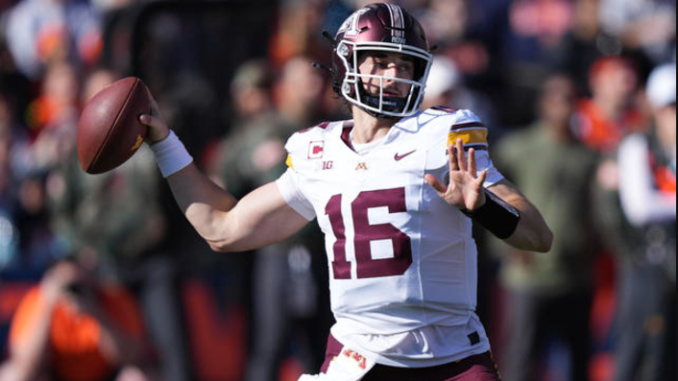
During Max Brosmer’s time in New Hampshire, spring practice took place early in the morning and occasionally followed a snowstorm.
For the Wildcats to hold those 6 a.m. practices in the freezing air, further chilled by the coastal winds, the field required plowing first. With no place to set the piles except at the entrance, players had to tie their cleats and scale 10-foot drifts to begin the session.
“If we had the chance to practice indoors, we definitely would have, but I believe it teaches you many lessons,” remarked Brosmer, who moved to Minnesota this year. “Incorporating individuals from various backgrounds enables your team to gain new perspectives and ultimately strengthens their cohesion as a group.”
In the FCS, indoor facilities are mainly a desire, not a reality — similar to the meals, tutors, and various other perks of being in a major conference program. Becoming part of the Gophers has provided Brosmer, a sixth-year quarterback savoring his only Big Ten season, with immense gratitude and a deep sense of satisfaction from fulfilling his ambition to play at the pinnacle of college football.
Brosmer ranks seventh in the conference for pass efficiency rating and sixth in completion percentage, having thrown 14 touchdowns while only tossing four interceptions and rushing for four more touchdowns. His capacity to quickly understand the offense upon arrival has propelled Minnesota into the unusual position of calling more passing plays than rushing plays for the first time in 17 years.
During the recruitment process, he informed coach P.J. Fleck and co-offensive coordinator and quarterbacks coach Greg Harbaugh that he desired to have complete control of the offense on the field, and he has consistently amazed the staff with his deep involvement and commitment to the weekly game plans and film sessions.
“I’ve never experienced a relationship with a player like him that allows for this kind of dialogue,” Harbaugh stated.
Starting cornerbacks Jack Henderson, now in his second season following his transfer from Southeastern Louisiana, and Ethan Robinson, in his first season after moving from Bucknell, have provided the Gophers with an FCS influence in the secondary as well. Equally significant as talent in the choice to grant them scholarships was their attitude.
“I’m not claiming it’s only due to our financial situation, but it aligns with our resources and our capacity to have appreciative players at this university, within our program, and in our locker room,” Fleck stated. “They’re truly talented players and great individuals, and I believe it’s an area we’ll keep prioritizing.”
Following Minnesota’s victory over Rhode Island earlier this season, Rams coach Jim Fleming remarked that Gophers assistants were attempting to recruit some of his players on the field after the game concluded, a strategy he conveyed to Fleck during their postgame handshake that he found objectionable.
Fleming stated in an interview with The Associated Press, “I remarked, ‘Look, I know I wouldn’t have done that.'”
For programs like Minnesota, which are generally average and cannot specify their NIL offers for top recruits, whether coming straight out of high school or through the transfer portal, the FCS could serve as a valuable resource for adding depth or, sometimes, discovering a significant player like Brosmer, even if it necessitates moving up two tiers.
In 2021, Nebraska punter Brian Buschini earned FCS first team All-American honors while playing for Montana. Luke Newman, the starting left guard for Michigan State, transferred from Holy Cross. Rutgers’ top receiver, Dymere Miller, moved to the team from Monmouth. Wisconsin features two defensive additions, John Pius (William & Mary) and Elijah Hills (Albany), sourced from the FCS, along with starting cornerback Nyzier Fourqurean, who advanced three levels from NCAA Division II team Grand Valley State.
“Occasionally, you encounter individuals who are exceptionally driven, unlike others who might be shifting laterally, often for a reason, such as failing to achieve success in their prior position or lacking the required work ethic,” remarked Badgers coach Luke Fickell, who vigorously recruited from the FCS level in his former role at Cincinnati.
The other major conferences are receptive to it as well. Colorado coach Deion Sanders transferred a lot of talent from Jackson State, beginning with standout two-way player Travis Hunter. Oklahoma’s top receiver, tight end Bauer Sharp, transferred from Southeastern Louisiana. Virginia’s second-most productive receiver, tight end Tyler Neville, moved from Harvard. California’s top tackler, Teddye Buchanan, transferred from UC Davis.
Next is Pittsburgh running back Desmond Reid, named by the AP at midseason as the most unexpected player in the ACC, who joined offensive coordinator Kade Bell from Western Carolina.
Reid began the week positioned fifth in the FBS for total yards gained from scrimmage. In a victory against Cincinnati earlier this season, he made history as the first player in Panthers’ history to achieve over 100 receiving yards and 100 rushing yards in a single game. One reason he was ignored by the other FBS? He stands at 5-foot-8.
“Players are found all over,” Bell stated. “It doesn’t matter what tier you compete in.”

Leave a Reply